(Editor’s note: The review has been republished on account of the Reno 5 Pro 5G’s first sale today, 22 January) 2020 saw a lot of smartphone manufacturers jump into the low-cost flagship territory, or the low end of the premium segment. While Xiaomi had a big surprise when it announced its
**Mi 10 5G (Review)** (it’s first solid premium contender), the lower-priced
**Mi 10T Pro (Review)** was a delight, given its camera capabilities and cut-throat pricing. Samsung, of all manufacturers, also decided to dip its feet into the segment. It launched the
**Galaxy S20 FE (Review)** , which did not do well in our review, partially because it can’t part ways with the hot-headed Exynos chipset in India. And now, we have Oppo. Launched at Rs 35,990, the Reno 5 Pro 5G takes the risky Samsung route of going with a different chipset. And it’s not just a brand-new chipset for the Indian market, but a high-end one with integrated 5G that’s meant to level-up and compete with the mighty Snapdragon 865. [caption id=“attachment_9225491” align=“alignnone” width=“960”] Launched at Rs 35,990, the Reno 5 Pro 5G takes the risky Samsung route of going with a different chipset. Image: Tech2/Sheldon Pinto[/caption] But Oppo has another angle here, and that’s design. As it stands today, the Reno is the slimmest and the lightest of the lot. And while slim and light is a good thing, it usually translates to heating issues and shorter battery life. Still, I put the Reno 5 Pro through its paces for a few weeks and here is my detailed review.
Slim and sexy design with a curvy display
The Oppo Reno 5 Pro 5G is the lightest smartphone in its segment. Given that its competition – the Mi 10T Pro, Galaxy S20 FE and the OnePlus 8T – are quite heavy, the Reno 5 feels like heaven after using those. This, along with its slim 7.6 mm waistline (that happens to be thinner than the Reno 4 Pro) gives it an excellent hand-feel, which is unheard of in this price range. [caption id=“attachment_9225501” align=“alignnone” width=“1280”] The Oppo Reno 5 Pro 5G is the lightest smartphone in its segment. Image: Tech2/Sheldon Pinto[/caption] I received the “Astral Blue” unit for review and it looks quite unique with its shimmery blue “Panda” glass back. The two colour variants (“Astral Blue” and “Starry Black”) differ when it comes to the materials used at the back. This has been done to get the desired visual effect and I must say, the “Panda” glass with the “Astral Blue” finish felt quite sturdy and did not scratch, nor gather any fingerprints whatsoever. The “Starry Black” finish uses Corning’s Gorilla Glass 3. [caption id=“attachment_9225511” align=“alignnone” width=“1280”]
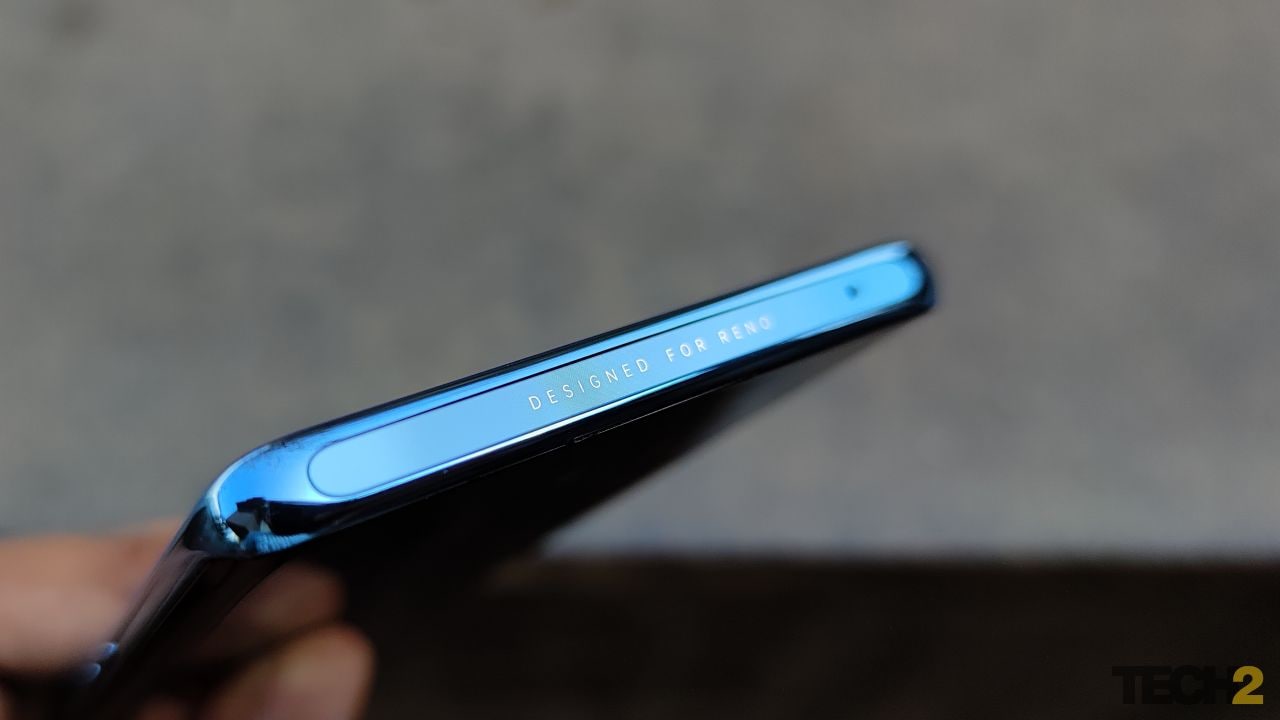 I received the “Astral Blue” unit for review and it looks quite unique with its shimmery blue “Panda” glass back. Image: Tech2/Sheldon Pinto[/caption] The slim and light design is also possible because of the plastic frame/chassis. It helps bring down the weight of the device, and also lets Oppo’s designers experiment with the top end of the frame by including a cool-looking glass insert. It’s all in the details, and you can tell that Oppo took its time to deliver something special for this segment. [caption id=“attachment_9225591” align=“alignnone” width=“1280”]
I received the “Astral Blue” unit for review and it looks quite unique with its shimmery blue “Panda” glass back. Image: Tech2/Sheldon Pinto[/caption] The slim and light design is also possible because of the plastic frame/chassis. It helps bring down the weight of the device, and also lets Oppo’s designers experiment with the top end of the frame by including a cool-looking glass insert. It’s all in the details, and you can tell that Oppo took its time to deliver something special for this segment. [caption id=“attachment_9225591” align=“alignnone” width=“1280”]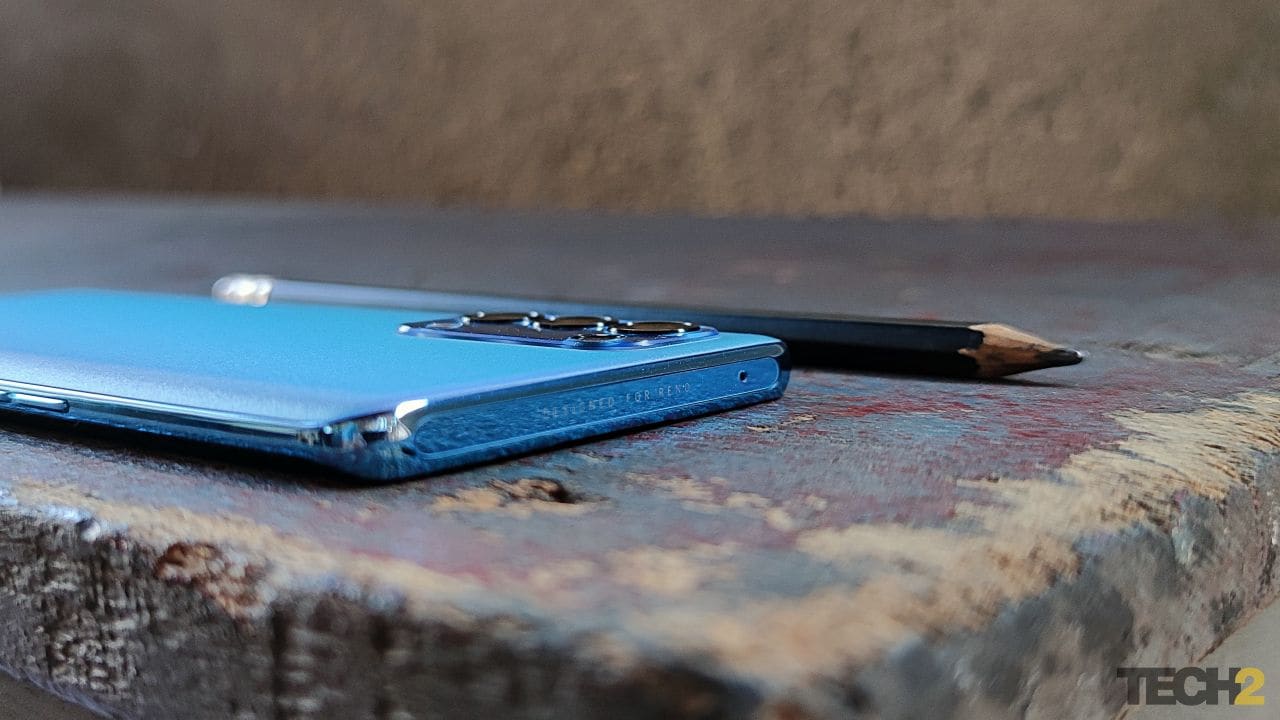 This budget flagship from Oppo is pencil-thin! Image: Tech2/Sheldon Pinto[/caption] Just like the Reno 4 Pro, Oppo has managed to squeeze in not just an FHD+ OLED display, but one with a 90 Hz refresh rate. The curved edge panel, despite looking similar to the one on the Reno 4 Pro, isn’t the same. It’s quite the upgrade, both in terms of colour reproduction (that’s now warmer and more accurate), and brightness levels (that can touch 800 nits). [caption id=“attachment_9225531” align=“alignnone” width=“1280”]
This budget flagship from Oppo is pencil-thin! Image: Tech2/Sheldon Pinto[/caption] Just like the Reno 4 Pro, Oppo has managed to squeeze in not just an FHD+ OLED display, but one with a 90 Hz refresh rate. The curved edge panel, despite looking similar to the one on the Reno 4 Pro, isn’t the same. It’s quite the upgrade, both in terms of colour reproduction (that’s now warmer and more accurate), and brightness levels (that can touch 800 nits). [caption id=“attachment_9225531” align=“alignnone” width=“1280”]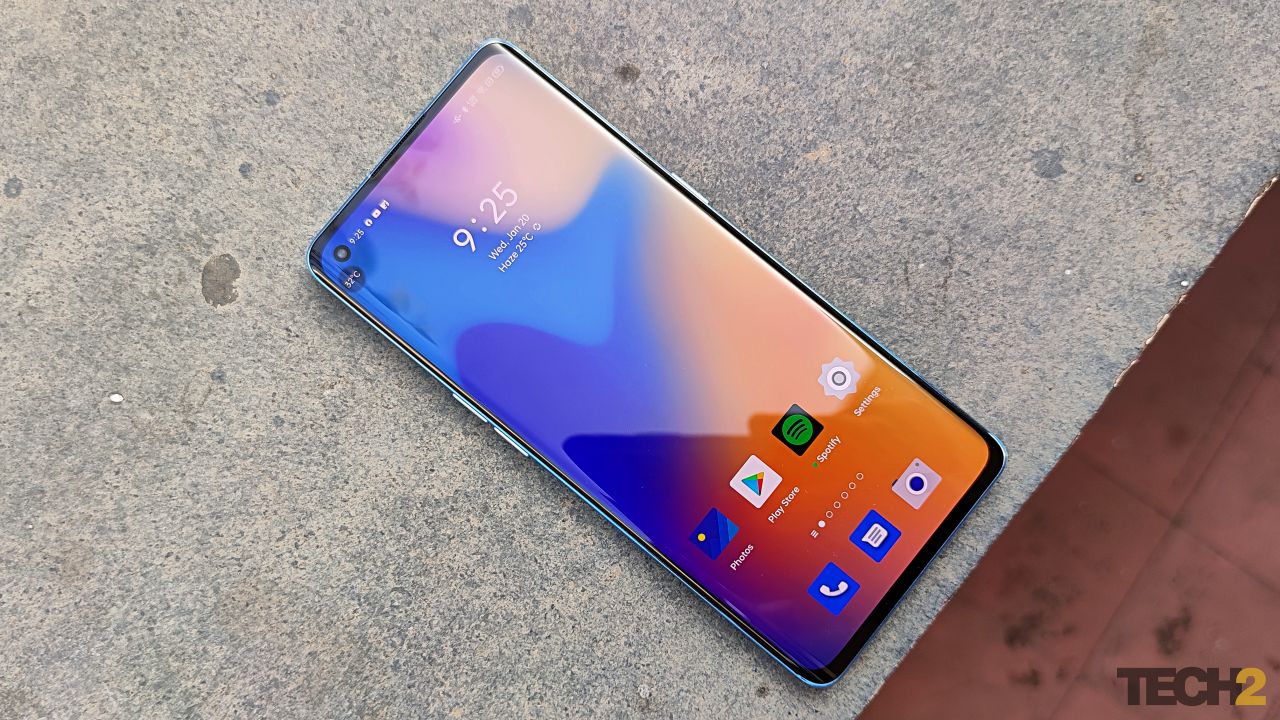 Just like the Reno 4 Pro, Oppo has managed to squeeze in not just an FHD+ OLED display, but one with a 90 Hz refresh rate. Image: Tech2/Sheldon Pinto[/caption] This made for a better outdoor viewing experience than the Reno 4 Pro, and definitely delivered when it came to those deep blacks while streaming movies in FHD. While Oppo claims that it is HDR10+ capable, Netflix did not let me stream shows in HDR, and the playback specifications also mentioned that it could not. Still, the video looks crisp, with deep blacks and the screen gets bright enough when viewed outdoors, whether that’s for movie streaming or gaming. This is a big deal, as no other smartphone brand includes such a display in this price bracket, and the 90 Hz refresh rate sweetens the deal for gamers.
Just like the Reno 4 Pro, Oppo has managed to squeeze in not just an FHD+ OLED display, but one with a 90 Hz refresh rate. Image: Tech2/Sheldon Pinto[/caption] This made for a better outdoor viewing experience than the Reno 4 Pro, and definitely delivered when it came to those deep blacks while streaming movies in FHD. While Oppo claims that it is HDR10+ capable, Netflix did not let me stream shows in HDR, and the playback specifications also mentioned that it could not. Still, the video looks crisp, with deep blacks and the screen gets bright enough when viewed outdoors, whether that’s for movie streaming or gaming. This is a big deal, as no other smartphone brand includes such a display in this price bracket, and the 90 Hz refresh rate sweetens the deal for gamers.
Gaming performance falls a bit short
The downsides of going slim and light are inevitable. There’s no 3.5 mm headphone jack and the phone also skips on a stereo dual-speaker setup. Sadly, Oppo does not throw in a 3.5 mm headphone adapter, but they do provide Type-C earphones in the box, and the audio quality is top-notch. The single speaker is quite loud, but completely lacks bass thanks to the slim design of the smartphone. [caption id=“attachment_9225521” align=“alignnone” width=“1280”] There’s no 3.5 mm headphone jack and the phone also skips on a stereo dual-speaker setup. Image: Tech2/Sheldon Pinto[/caption] Another downside of going slim and light is heat. The natural enemy of any flagship smartphone, it’s the sole reason why most manufacturers are willing to sacrifice design over performance in this price bracket. Still, things are not as bad as I expected them to be. The Oppo Reno 5 Pro is the first smartphone in India to pack in MediaTek’s recently announced Dimensity 1000+ chipset. It integrates 5G and is supposed to be a Qualcomm Snapdragon 865 alternative, at least on paper. In day-to-day use, performance is top-notch and I did not face a single hiccup or stutter. You might guess that there was a Snapdragon 865 inside, if Oppo didn’t tell you otherwise. While benchmarks will tell you that there is a noticeable performance gap between the two flagship chipsets, it’s the gaming performance that reveals the real picture. [caption id=“attachment_9225561” align=“alignnone” width=“1280”]
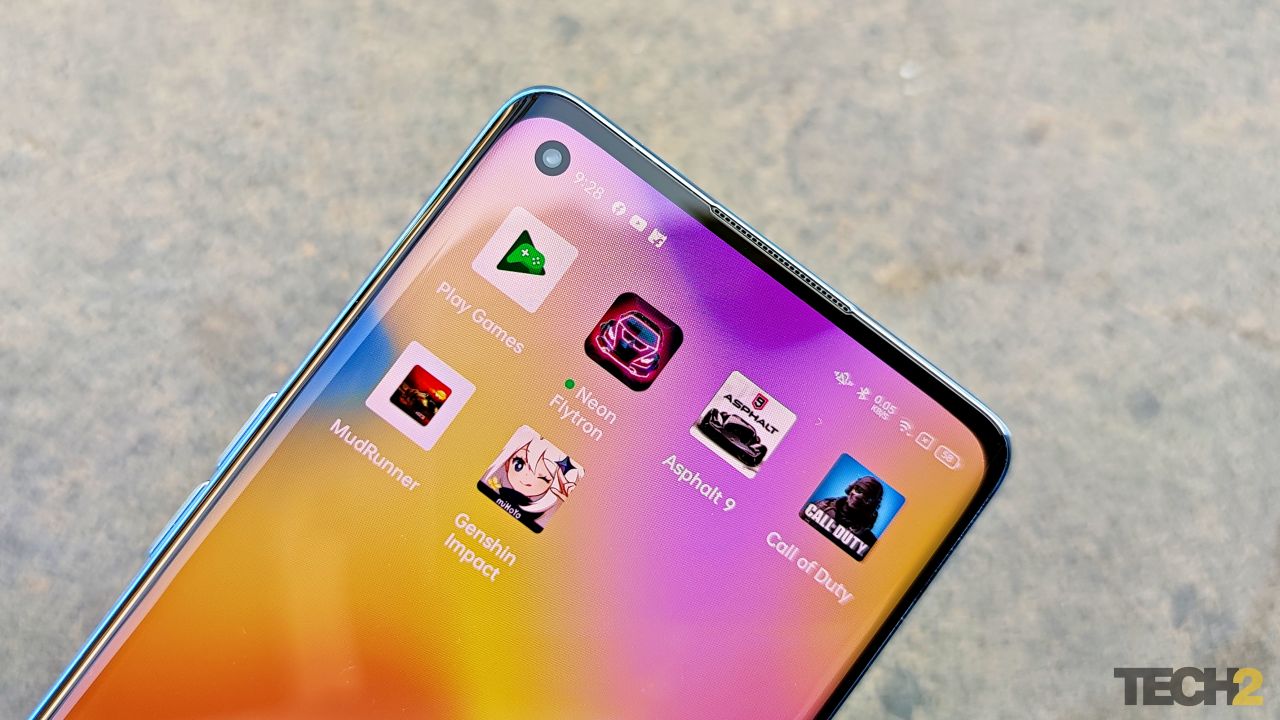 In day-to-day use, performance is top-notch and I did not face a single hiccup or stutter. Image: Tech2/Sheldon Pinto[/caption] Loading up Call of Duty: Mobile, the Reno 5 Pro let me run the game smoothly at the default ‘High’ graphics and ‘High’ framerate. The device warmed up a bit but did not interfere with the gaming experience. Crank up the settings to ‘Very High’ (graphics and frame rate), and you will notice how quickly the phone gets hot. It barely took me one ‘Frontline’ tournament to get the phone up to 40 degrees. In my second go, I took a risk and continued playing a couple of matches, and noticed dropped frames and slowdowns, something that I expected. This behaviour was repeated with another popular title, Asphalt 9: Legends. Crank up the graphics settings to ‘High Quality’ (with 60 fps ON) and you will notice how the phone warms up (and chipset throttles down) as the frames start to drop. In short, this is not a smartphone that’s meant for heavy gaming. But for those who crave a slim and light device, it still can run demanding games at default settings without any hiccups. I could have compared the performance of the Reno5 Pro to the Mi 10T Pro, but the latter is priced higher by about Rs 5000. If gaming is your thing, then the latter would be a better choice because of the chipset, the cooling tech and the high 144 Hz refresh rate display with 240 Hz touch sensing.
In day-to-day use, performance is top-notch and I did not face a single hiccup or stutter. Image: Tech2/Sheldon Pinto[/caption] Loading up Call of Duty: Mobile, the Reno 5 Pro let me run the game smoothly at the default ‘High’ graphics and ‘High’ framerate. The device warmed up a bit but did not interfere with the gaming experience. Crank up the settings to ‘Very High’ (graphics and frame rate), and you will notice how quickly the phone gets hot. It barely took me one ‘Frontline’ tournament to get the phone up to 40 degrees. In my second go, I took a risk and continued playing a couple of matches, and noticed dropped frames and slowdowns, something that I expected. This behaviour was repeated with another popular title, Asphalt 9: Legends. Crank up the graphics settings to ‘High Quality’ (with 60 fps ON) and you will notice how the phone warms up (and chipset throttles down) as the frames start to drop. In short, this is not a smartphone that’s meant for heavy gaming. But for those who crave a slim and light device, it still can run demanding games at default settings without any hiccups. I could have compared the performance of the Reno5 Pro to the Mi 10T Pro, but the latter is priced higher by about Rs 5000. If gaming is your thing, then the latter would be a better choice because of the chipset, the cooling tech and the high 144 Hz refresh rate display with 240 Hz touch sensing.
Silky-smooth software
Oppo recently announced ColorOS 11 based on Android 11. Fortunately, the Reno 5 Pro 5G is one of the first smartphones to get this software out of the box. I’ve reviewed Oppo ColorOS 11 separately (you can read the review
**here** ), but this is a final consumer build, and things have changed by a bit. Media Player controls that let you switch the output between connected audio devices from the notifications bar, finally makes it here. Touch sensitivity can now be customised while playing games using the Game Space floating window, and it does improve overall response when playing fast-paced FPS titles. [caption id=“attachment_9225541” align=“alignnone” width=“1280”] Media Player controls that let you switch the output between connected audio devices from the notifications bar, finally makes it here. Image: Tech2/Sheldon Pinto[/caption] But that’s pretty much it, as everything else remains the same as in the beta builds, including the hard-to-execute Flex Drop floating window feature. Still, ColorOS 11 is the king of customisation (with customisable fonts, icons, AOD, dark mode and more) and is also well-optimised for the MediaTek chipset when it comes to day-to-day multi-tasking and app performance. That, combined with the fluid 90 Hz display, makes for a buttery-smooth software experience.
A capable camera
The 64 MP primary camera is the only upgrade from the camera on the Reno 4 Pro I reviewed last year. While the camera performance on the Reno 4 was satisfactory, Oppo has taken things up several notches with the Reno 5 Pro in terms of performance. [caption id=“attachment_9225601” align=“alignnone” width=“1280”] The 64 MP primary camera is the only upgrade from the camera on the Reno 4 Pro I reviewed last year. Image: Tech2/Sheldon Pinto[/caption] Overall quality of photos shot in daylight is impressive. Still images come out clean, with the right amount of sharpness and detail. The camera, just like the Reno 4 Pro’s camera, also has a tendency to overexpose. This is less to do with the hardware and more to do with the AI or software, as it only triggers the HDR (set to Auto) when it’s dead-obvious that there’s work to be done in the scene. In most cases, it does not, and that leads to images with plenty of clipped highlights. Whether you are shooting a white bowl with fruit (bowl gets clipped) or a person against a background (white clothing and bright backgrounds get clipped). The photos still look quite good, as Oppo’s algorithms always ensure that the subject is correctly exposed. It’s just the HDR that acts a bit lazy from time to time. The new sensor also brings faster autofocus and better dynamic range across the board, and this also applies to portrait shots and low light photos.
Click here to see the camera samples:
Post sunset or in dimly lit rooms, photos come out surprisingly well; it’s just that they fall a bit short of dynamic range, with crushed shadows. Noise is also well under control. In fact, in most cases (unless it was really dark) I never needed to use the troubled ‘Night’ mode. I say “troubled” because it almost always delivers blurry images. I’m unclear as to why this happens, but it’s possibly down to the image stacking, where the camera may be choosing some blurry frames that ruin the final image. So, if you do purchase this smartphone, use the ‘Night’ mode only when you can keep the device really steady. The 32 MP selfie camera shoots impressive selfies no matter what the lighting conditions. Edge detection was also spot-on. While the ultra-wide angle camera was useful in daylight, the results were not really usable in low light. The 2 MP macro is solely in place to fill up the spec sheet. The Reno 5 Pro can record 720p and 1080p video at 30 and 60 fps, and 4K video at 30 fps. I sorely missed a 4K 60 fps mode, here that would have delivered better clarity and detail in the videos. Video recording is pretty average for a flagship smartphone, because most of the footage I shot turned out quite shaky. I definitely expected something better here, given that phones that cost a few thousands more, offer video recording quality that is leagues better. When there’s enough light, 4K footage looks quite good, but with oversaturated colours. The 1080p @30 fps mode delivered better colour with less detail, but better stabilisation. I also tried out the “Ultra Night” video that’s supposed to improve detail, clarity and dynamic range when shooting video in low light. It works fine on street-lit scenes, but it ruins the video in an environment that’s already lit up. In spaces with mood lighting, it cranks up the saturation making the colours look unreal. In short, I was happier with the regular results. Also, it only works at 1080p.
Blazing-fast charging
Slim smartphones usually fall short on battery life. I expected the worst when it came to the Reno 5 Pro, especially when you consider that flagship MediaTek Dimensity 1000+ chipset inside. But just like the Reno 4 Pro, the Reno 5 Pro manages to impress and delivers a whole day of battery life on a single charge. If you game less, then you will easily manage about a day and half of battery life on a single charge, which is impressive for a device this slim. [caption id=“attachment_9225571” align=“alignnone” width=“1280”] If you game less, then you will easily manage about a day and half of battery life on a single charge, which is impressive for a device this slim. Image: Tech2/Sheldon Pinto[/caption] More impressive is the in-box 65 W SuperVOOC charger. It fills up that 4350 mAh battery in about 30 minutes, which is the fastest charging speed you can get in this segment! Second in line would be Realme’s X50 Pro (that’s priced a lot higher), followed by everything else.
Should you buy one?
While the Reno 4 Pro found itself in the doldrums soon after launch given its odd pricing (and the existence of the
**OnePlus Nord**) the Reno 5 Pro 5G has certainly done better. It’s managed to carve out its own niche in the budget flagship segment (Rs 35,000-45,000) and with that, it’s easy to recommend given that it also looks stunning. [caption id=“attachment_9225581” align=“alignnone” width=“1280”] You get a 90 Hz curved edge OLED display, capable 64 MP camera, slim eye-catching design, class-leading charging speeds and it’s not heavy on your wallet. Image: Tech2/Sheldon Pinto[/caption] Those into hardcore gaming will have to give this beauty a pass, solely because it gets a bit hot and slows down when you max out the graphics. But the rest of it is as good as it gets at Rs 35,990. You get a 90 Hz curved edge OLED display, capable 64 MP camera, slim eye-catching design, class-leading charging speeds and it’s not heavy on your wallet. Still, If you crave more power (especially for gaming) or 8K video, and are ok with something chunky, then your obvious choice should be Xiaomi's Mi 10T Pro that will cost you an additional Rs 5000 (at Rs 39,990).


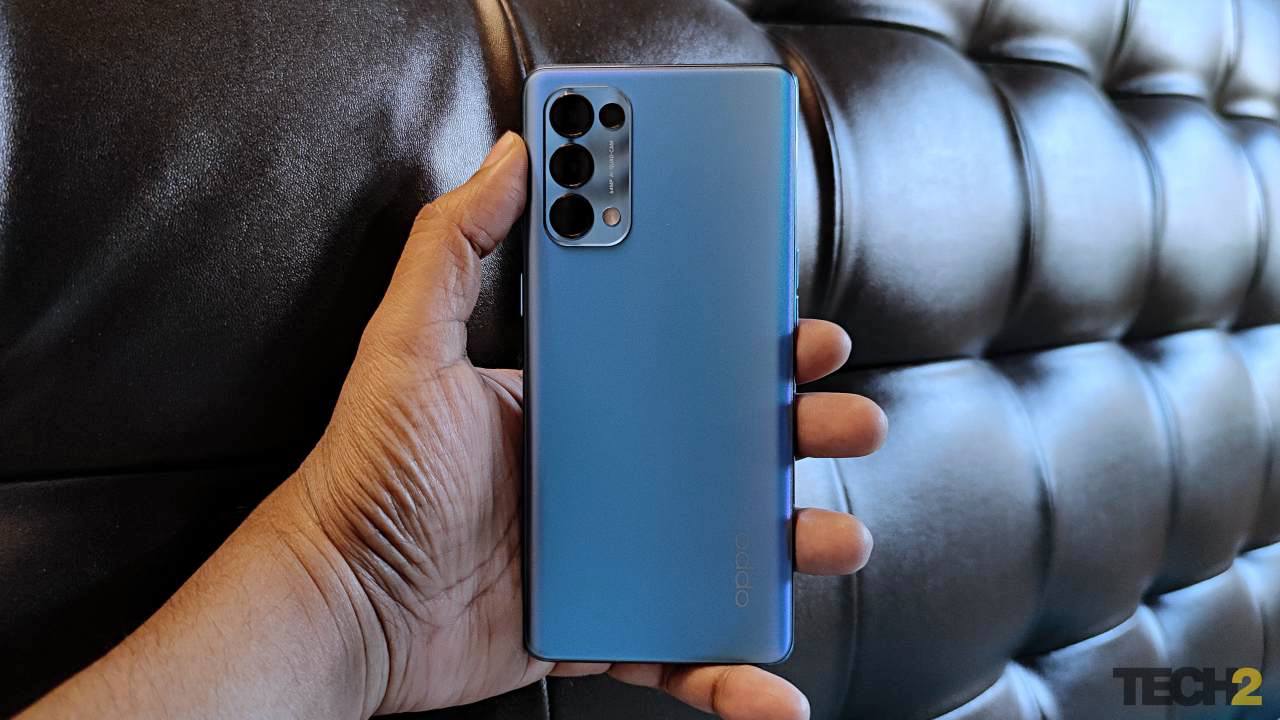)
)
)
)
)
)
)
)
)



